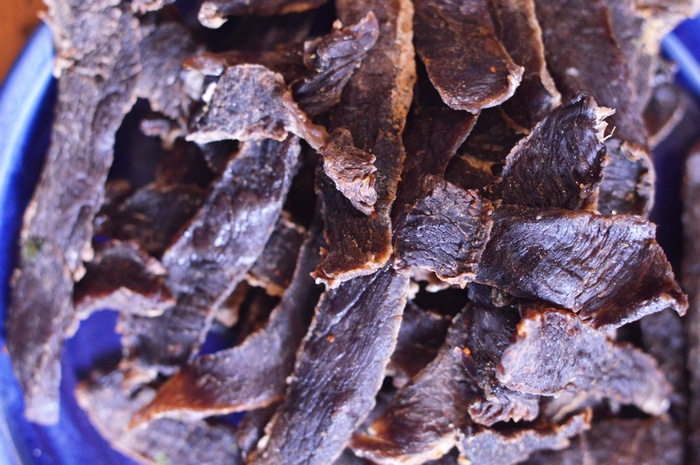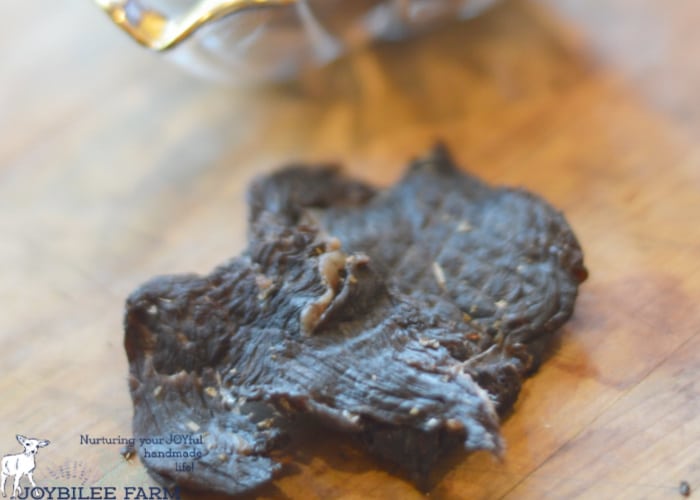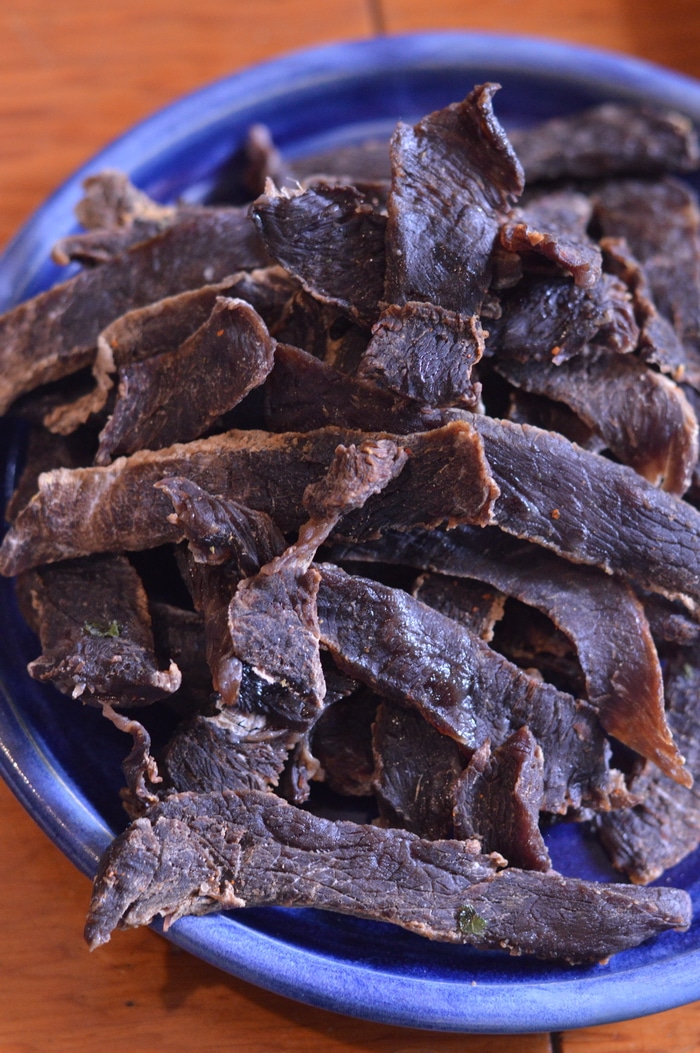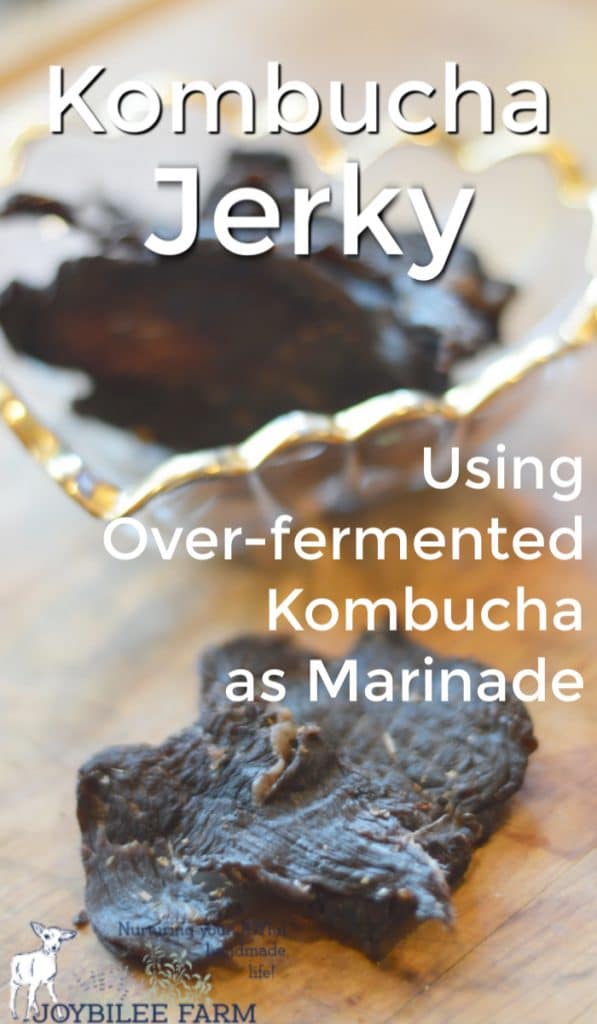Kombucha is the perfect vinegar substitute for marinading meat before it is being dried for jerky. The lactic acid and acetic acid in Kombucha add probiotics to the meat that overwhelm harmful bacteria and keep the meat from spoiling. The acid tenderizes the meat.
After making kombucha for a while, everyone ends up with that one jar that ferments just a bit too long and makes vinegar. Kombucha vinegar has many of the same properties that apple cider vinegar has. It is slightly sweet, raw, and full of helpful probiotics.
One of my new favorite uses of kombucha vinegar is using it to make beef jerky.
Vinegar is used as a meat tenderizer in the standard jerky recipe. However, when using kombucha vinegar you get the added benefit of the probiotics being able to ferment the meat while it is in the marinade. Jerky is a raw meat product, which is preserved by a combination of the spices, the probiotics, and the thorough drying.
All three preservation aspects combine to give an amazingly tasty and enzyme-rich jerky.
Jerky marinade recipe using over-fermented kombucha:

Kombucha Jerky Marinade
Description
Use beef or other lean and inexpensive meat: You will need to trim off all fat, so try to get fairly lean meat when you plan to turn it into jerky. Good options include round steak, flank steak, or loin from beef, However, beef is not the only meat option, turkey, goat, lamb, or whatever lean meat you have on hand can be substituted in. Don’t use pork for this recipe.
Ingredients
Instructions
- Put kombucha in a 2 quart/litre pyrex dish and add thinly sliced round steak, flank steak, or loin from beef, lamb, goat, or other red meat. Don’t use pork for this recipe.
- Cover the meat completely with this marinade.
- Cover the dish with plastic wrap and place it in the refrigerator for 8 to 12 hours.
- Drain and without rinsing, place in your dehydrator in a single layer
- Use an electric dehydrator set at 160F for four to six hours.
Use beef or other lean and inexpensive meat for jerky
You will need to trim off all fat, so try to get fairly lean meat when you plan to turn it into jerky. Good options include round steak, flank steak, or loin from beef, However, beef is not the only meat option, turkey, goat, lamb, venison or whatever lean meat you have on hand can be substituted in. Don’t use pork for this recipe.
Marinade Ingredients
- 4 cups of Kombucha at a pH of 1 or 2
- 5 cloves of garlic, crushed
- 1/4 cup Worcestershire sauce
- 1 whole onion, finely minced or 2 tbsp dried minced onion
- 1 tsp. each dried sage, thyme, parsley, rosemary, cayenne (optional)
- 2 tbsp sea salt or Himalayan salt
- Put kombucha in a 2 quart/litre pyrex dish and add thinly sliced meat
- Cover the meat completely with this marinade.
- Cover the dish with plastic wrap and place it in the refrigerator for 8 to 12 hours.
- Drain and without rinsing, place in your dehydrator in a single layer
- Use an electric dehydrator set at 160F for four to six hours.
If you are starting with a fresh roast, put it in the freezer to chill while you prepare the marinade. If you are working with a frozen roast, pull it out to thaw about 3 hours before you start preparing the marinade. You will be able to make thinner cuts if the meat is slightly frozen.
Mix all marinade ingredients together in a glass dish. These can be added in any order. Stir everything together to make sure it is well blended.

Prepare the meat
Take your beef roast out of the freezer and partially thaw. Using a sharp knife, slice off all visible fat and, if there is any nerve sheathing, as much of that as you can. Fat and nerve sheathing will retard drying, and the fat will go rancid with exposure to air which will lessen the storage life of your jerky.
Once the meat is trimmed, slice it into thin, 1/4 inch, slices with the grain of the meat. For chewy jerky, cut with the grain of the meat. For brittle jerky, cut across the grain. After slicing, place the meat slices in your marinade. They should be fully covered with marinade.
Cover your marinating meat slices, and place in the refrigerator for 8 to 12 hours. This gives time for the marinade to fully permeate the meat, and for the kombucha bacteria to help get rid of any unwanted bacteria in the meat.

Jerky dehydrating instructions
After 12 hours, place the marinated meat on dehydrator trays and dry at 160F until fully dry and crisp. This can take up to 16 hours for thicker slices. Flip the slices, and turn your dehydrator trays (if your dehydrator design requires it) at least once every 4 hours during the dry time to ensure even drying.
If you don’t have a dehydrator, you can dry in your oven on the lowest setting. Dry the meat on metal racks, over a baking tray, and turn frequently. If your oven won’t go down to 160F, then prop the oven door open with a wooden handled spoon to ensure that it doesn’t cook the meat instead of drying it.
Once the jerky is fully dry, let it cool and store it in glass jars or other relatively air-tight glass containers. It is not recommended to store jerky in plastic bags, except for short-term will-be-eaten soon storage. Properly dried jerky should be stored in the refrigerator for up to one month and in the freezer for up to 6 months.
Jerky is a handy trail food, and an easy way to preserve meat for later consumption. Beef jerky is an excellent addition in home-made dry soup mixes for a protein boosted convenience food, or eaten simply as-is as a raw protein and probiotic boost, at least when you make this kombucha jerky marinade.

More recipes for beef jerky that you can dry in your dehydrator here.
You might be interested in these other Kombucha recipes
6 Ways to Incorporate Kombucha into your Busy Lifestyle
Cranberry Kombucha for a Probiotic Holiday
Kombucha Benefits for Pennies a Dose
Kombucha Grainy Mustard
Kombucha Red Horseradish Sauce

Dive into dehydrating food:
If you’ve never dehydrated food before, you can start this year. Nearly any fruit or vegetable can be dehydrated. Dehydration is one of the most accessible methods of food preservation, and you don’t even need a dehydrator to get started. You can even dehydrate meat and full meals.
-
- What’s dehydrating, anyway?—Learn the basics of how dehydrating works, and the essential tips and tools you need to get started with your dehydrator.
- Dehydrating from A to Z—Discover how to properly dehydrate fruits and veggies, meat and fish, and even herbs and spices.
- Meals, snacks, and sides—Put your newfound knowledge to the test with recipes for classic dried foods like Kale Chips and Apple Leather, and full meals like Shepherd’s Pie and Curry Chicken with Rice.
- Pro-tips on food preparation, rehydration, and using your dehydrated food to boost flavor and nutrition.
Start drying your own food today with the Dehydrator Cookbook for Beginners.





Leave a Reply